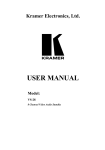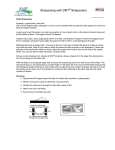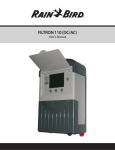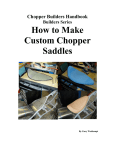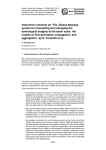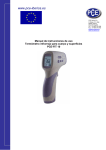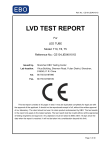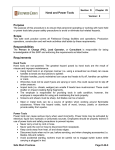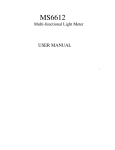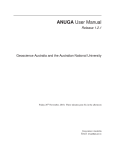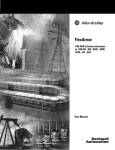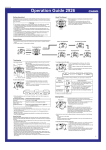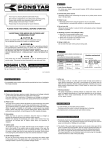Download THE BLADESHARPENER
Transcript
BLADESHARPENER THE OWNERS MANUAL Photo shows knife in 100mm flip over. All parts will interchange. Note: Wedge attachment (left of photo) for multipurpose use. We Supply: Knives Steels Oil Stones Gloves ‘F. Dick’ products All Abattoir equipment EZESHARP PTY LTD ABN 86 074 324 995 MANUFACTURERS OF THE BLADESHARPENER 1 BLADESHARPENER WITH FLIPOVER (No stones supplied) — FOR KNIVES ONLY Comes with 100mm flip over. Supplied complete in box. 1. Clamp unit to bench. 2. Fix “T Bar” to frame with knob. 3. Assemble flip over to frame. 4. Suggested angle setting for knives - “T” bar 40° - flip over 15° to 20°, then follow instructions to page 3. 5. Assemble stone frames and fix selected stones in frames. Stone frames for two 8”x2” stones or one 8”x2” / one 9”x3”. Spanners supplied for assembly. Flipover (pictured above) shows knife being flipped over after sharpening first side of knife. Bladesharpener with flipover for knives only. Note the stone frames are designed to take stones from 8x2x1 to 9x3x1. You simply clamp the knife in the flipover and set at any exact angle you require. Push stone over knife until sharp, as per instruction in manual - page 4. Photo shows knife being flipped over to sharpen other side while retaining the same exact angle and edge. Beware! Never leave any blade in your sharpener unattended. 2 A B Standard 100mm flip overs can be machined to take short or pocket knives. Note: knives to 7” can still be sharpened. Photo shows 100mm flip over plates machined to take pocket or short knives. Lower set are machined flip over plates and example knife. Item ‘A’ pictured above shows 100mm flip over. Item ‘B’ pictured above shows how flip over can be machined to take short knives or pocket knives. Beware! Never leave any blade in your sharpener unattended. 3 KNIFE SHARPENING INSTRUCTION (for most knives) 1. Set tee-bar at 40 degrees. Set main frame dial at 15 to 20 degrees. 2. Mix a stiff mix of detergent-water to lubricate stone. Apply with sponge. Or use kerosene and light oil mix. 3. Smear all screw threads and allen screws with vaseline. 4. Soak stone in water first so the mix will not soak in stone. 5. Clamp blade in flip-over or wedge. Don’t over tighten allen screws. 6. Smear rough side of stone with mix and with rod resting on tee bar rod, just push stone over blade from handle to point. If the blade is curved just follow the curve as you go down the blade. ‘Count’ the strokes it takes to get a burr on the under side of the knife or blade. 7. When you feel the burr from above process turn or flip blade over and stroke or sharpen the blade with the same amount of strokes you used in 6. Use the mix as required. 8. Turn or flip blade so burr is up. 9. Turn stone over so fine side is down and facing the blade. You are now going to hone the blade edge and remove the burr. 10. Very lightly run the fine stone from the handle to the point 8 times. 11. Turn blade over so burr is up and stroke 8 times as in 10. 12. Turn blade over so burr is up and stroke 6 times. 13. Turn blade over so burr is up and stroke 6 times. 14. Turn blade over so burr is up and stroke 4 times. 15. Turn blade over so burr is up and stroke 4 times. 16. Turn blade over so burr is up and stroke 2 times. 17. Turn blade over so burr is up and stroke 2 times. 18. Turn blade over so burr is up and stroke 1 times. 19. Turn blade over so burr is up and stroke 1 times. The blade is now finished. When using a steel you steel at the same angle you have created in the above process. We recommend a good quality fine stone for the honing and burr removal process. ★★★ To touch up knives each day leave the main frame setting as before and using very fine stone hone a few strokes each side of knife as required. ★★★ For sharpening shears and knives etc. using the Wedge Attachment please go to that page in the manual. Use same settings as for flip over. Beware! Never leave any blade in your sharpener unattended. 4 SERRATED EDGE KNIFE SHARPENING Fitting supplied with all sharpeners to take round or flat files. Photo shows fitting for serrated edge knives and how the file works. Angle setting same as for flip over for ordinary knives. “T” Bar 40 degrees, flip over 15 to 20 degrees or use your own settings. Photo shows round file to suit the serration of serrated edge knife to be sharpened. Different files are used for different serration sizes. The round fitting shown in photo will take a flat file as well as a round file. Beware! Never leave any blade in your sharpener unattended. 5 USING WEDGE: SMALL SCISSORS Dressing, Dressmaking, Home Style. Bevels: There are many varied angles. The best method of finding the factory bevel is by marking the existing edge with a marking pen. Abrasives. Norton IB8 Red India Comb. Hairdressing: Coarse/Fine/Hard Arkansas. Dressmaking/Home: Coarse/Fine Stone / File. PLEASE NOTE: Don’t sharpen special serrated edge on dressmaking scissors. A. Push into the edge from the tip to the handle and life on return strokes. Use basic countdown method of counting strokes of each blade. Be careful not to round the tip of the blade. Continue until the burr is raised along entire edge. Stop. Remove blade. Re-mount mating blade being careful to close scissors at this stage. B. Remove blades. C. Check tensioning screw and adjust and lubricate if necessary (See maintenance section). LARGE SCISSORS Grass and Lopping Shears etc. Bevels: Many varied angles. Try angle dial 40. T Bar height 70. Abrasives: Flat mill cut file or straight edges, or combination stone. Half round mill cut file or wavy edges. Disassemble. Face blades. Use the basic guidelines of use to set up blade. Repeat ‘B’ and ‘C’ of small scissors section. Reassemble. Burr removal is achieved by firmly closing blades. Check tension screw and adjust and lubricate if necessary. Beware! Never leave any blade in your sharpener unattended. 6 BLADESHARPENER WITH WEDGE (No stone supplied) — FOR MULTI PURPOSE SHARPENING MULESING & DAGGING SHEARS Here’s a tip or two on how to sharpen Mulesing and Dagging shears. (suggestion only) A. Set T bar on 70. B. Set the wedge dial at 24 to 28 for Mulesing shears. Set the wedge dial at 30 to 32 for Dagging shears. C. Place blade parallel in wedge, then clip other blade behind special lip under wedge. D. Sharpen using a mixture of kerosene and neatsfoot oil 70/30% or liquid detergent with water mix, as this will keep your stone with a keen cutting face at all times. E. Sharpen from the tip to handle using a fine stone until burr appears along entire length of the blade. Place stone on a flat surface, on the back of blade remove burr. Repeat 3 or 4 times using light pressure on the stone. Remove shears from the machine. Once again rub stone on flat surface of shears to remove burr, then cross blades 3 or 4 times (very important as this makes sure that no burr remains). F. Use same method for Dagging Shears. G. Remember that you can alter these angles if it suits your particular situation. A Photo shows blade tucked under wedge out of the way. The chain & cup (item ‘A’) is for covering scissor blade that is standing up when sharpening - eye protection. Beware! Never leave any blade in your sharpener unattended. 7 USING WEDGE: TIN SNIPS Suggested Angle Dial 70 T Bar height 90 Abrasive - Use flat mill cut file Release blades and close blades firmly to cut off the burr. PLANES, CHISELS, BUZZER AND HAT CUTTER BLADES All bevels depend on the type of material you are cutting. CHISEL AND PLANE BLADES Shoulder Bevel - Suggested Angle Dial 40. T Bar Height 60. Edge Bevel Angle Dial 20 T Bar Height 60. Mount chisel as shown to keep blade square. BUZZER BLADES Single Bevel - Suggested Angle Dial 10. T Bar Height 65. Abrasives - Combination Stone/Arkansas NOTE: Use of a wooden wedge as shown will keep the clamp face square. This is important on narrow blades, especially chisels. Beware! Never leave any blade in your sharpener unattended. 8 HOW IT WORKS The “Bladesharpener” works by clamping the blade to be sharpened in a rotatable vice-like clamping jig with degree angle adjustments. An oil stone, file or diamond stone can be used resulting in no loss of temper in the blade being sharpened. The ‘T’-bar guides the stone at a very accurate and steady angle in relation to the blade being sharpened. Infinite angle adjustments together with the ‘T’-bar, gives the operator total control over movement, pressure and angle. This degree of control and safety, and the ability to sharpen such a wide range of blades, to either factory specifications or to create a variation to suit the work or individual make the “Bladesharpener” totally unique. The “Bladesharpener” takes the guess work out of sharpening by providing control and repeatability of the correct sharpening angle (the true secret of sharpening). ABRASIVE OPTIONS Any 8”x2”x1” or 9”x3”x1” oil stones. ALUMINIUM OXIDE – called India Stones or Wheatstone cuts a fine finish with shallow scratches. SILICON CARBIDE (Carborundum) – A fast cutting stone. WASHITA (Soft Arkansas) – Natural stone for fast cutting and relatively fine sharpening. HALLS BLACK OR WHITE ARKANSAS (Extra fine) – This extra hard natural stone is used for precision polishing on already sharp edges or for intricate tools for the professional. DIAMOND STONES – Various shapes and sizes can be accommodated. MOVEMENTS AND PRESSURE Experimentation will find the best method for each blade. The simplest but very efficient method of push and lift on the return stroke, and counting the strokes works well. With this plus attention to the pressure used, you can’t go wrong. Basically you start heavy on pressure and strokes, and gradually lighten pressure and reduce the strokes as you near the goal of a sharp edge. All blades can be sharpened this way. Finish by using the weight of the stone just gliding over the stone. This method is called countdown. The countdown is used to finish a blade that has a correct and even bevel but has lost it’s edge. The edge can be restored quickly by the countdown method. CROSSING BLADES This is a method of burr removal for scissors type blades. After sharpening, the burr needs to be returned or removed. This is done by crossing the blades. Close the blades carefully but at the same time trying to stop the newly sharpened (with burr on) blades from touching each other. There is usually enough slack in the tensioning screw to allow this. Once you have the blades closed, press the blades together with your thumb and index finger. Open the blades. Wipe off the burr with a piece of clean cloth. Repeat the blade crossing. Wipe, then work the blades normally. Beware! Never leave any blade in your sharpener unattended. 9 MAINTENANCE SECTION GENERAL CARE OF YOUR BLADESHARPENER Due to the very nature of the type of work for which the Bladesharpener is used it is essential to keep the Bladesharpener clean and well lubricated to ensure smooth operation. Wash the unit if needed and spray some C.R.C. or similar dewatering compound on the guide rods and apply vaseline on the threads to keep the Bladesharpener in good working condition. After use close the jaws of the wedge to protect its thin edge. STONE CARE 1. To keep stone flat and level, rub two stones together with a mixture of Neatsfoot oil and kerosene (30:70). Rub firmly together until hollow of stone is removed. 2. To keep stone clean, with a keen cutting edge, use a 30% Neatsfoot oil and 70% Kerosene mixture or detergent and water mix on the stone when sharpening. 3. If a stone is clogged, soak in petrol or kerosene, then rub clean with a stiff brush. 4. Household detergent may be used as a lubricant. Beware! Never leave any blade in your sharpener unattended. 10 THE BLADESHARPENER MADE BY: EZESHARP PTY LTD ABN 86 074 324 995 TRADE ENQUIRIES WELCOME PO BOX 7309, CAIRNS 4870 Q. AUSTRALIA WEB SITE: www.ezesharp.com.au EMAIL: [email protected] PHONE: (07) 4056 6416 FAX: (07) 4056 5945 INT. PHONE: +617 4056 6416 INT. FAX: +617 4056 5945 We supply all brands of knives, steels, diamond and oil stones and abattoir equipment at competitive prices. Please enquire. 11











